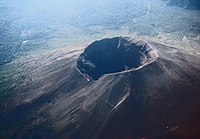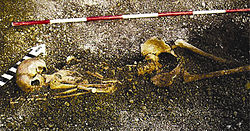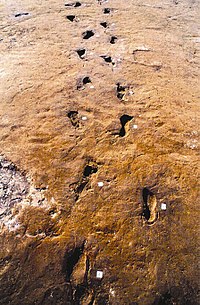Volcanoes/Mount Vesuvius

Mt. Vesuvius is characterized as a "stratovolcano", or composite volcano, which means it is made up of pyroclastic material and lava. Vesuvius is the only volcano in the European mainland to have erupted within the last hundred years. Mount Vesuvius was known for its eruption in AD 79 and was named after the biologist Pliny. Since then, this volcano has erupted more than 50 times. Scientists have studied that this volcano is dormant. Its last eruption was in 1944, but is still capable of erupting. Mt. Vesuvius is located on the coast of the Bay of Naples about six miles from a short distance inland from the shore.
Formation
Mount Vesuvius is caused by the African plate sinking underneath the Eurasian plate which therefore created a convergent boundary in the Bay of Naples, Italy. Later, Mount Vesuvius reached the surface and had attached to Italy due to the deposits from the eruptions since 479 A.D. As the surface cooled with the mantle is still heated 4.6 million years ago, part of the African plate melted to magma, rises up to the surface as a result of creating a volcano.
Mt. Vesuvius is composed of a mix of layers of lava flows and volcanic ash. It lies inside Mount Somma, a summit caldera. Two tectonic plates, African and Eurasian, collided. The heat that was made melted the rocks. Because magma is less dense, it was pushed upward. It found a weak point at the Earth's surface and it broke through forming a volcano.
Appearance
Mount Vesuvius is a composite volcano because its eruptions vary often from pyroclastic material to lava flows. It can be explosive like its most famous eruption in August 24, 79 A.D. which caused ashfalls, volcanic impact, and mudflows onto Pompeii and Herculaneum, or nonexplosive like in May 1, 1855 which a lava flow invades Massa and San Sebastiano. Mount Vesuvius stands as high as 4190 feet. It's composed of a volcanic cone, named Gran Cono, inside a summit caldera, called Mount Somma.
This volcano has a humpbacked shape and a large cone surrounded by the caldera caused by the collapse of Mount Somma. The height of Vesuvius is 4,202 ft. The slopes of the mountain filled with lava flows. Many layers of lava, volcanic ash, and pumice make up the mountain. Vesuvius is at a convergent boundary where the African plate is being subducted meaning one tectonic plate is moving under another.
History and Eruptions
"For the last two million years, the region of central and southern Italy has been the scene of active volcanism, characterized by explosive eruptions. This region is known among geologists as the Roman Comagmatic Province and extends along the Tyrrhenian coast, from the Vulsini area in northern Latium to Vesuvius in the south. In north Latium the volcanic activity became largely extinct about one hundred thousand years ago, but the Romans have ever since enjoyed the beautiful volcanic landscape created by this activity, such as the scenic Lake Bolsena in the caldera of Vulsini volcano, and Lake Vico. Further south, however, in the Campanian volcanic region, activity has continued up to the present day, as recorded in legend, history, and in the volcanic stratigraphy of Vesuvius and the Phlegraean Fields."[1]
3800 b2k


The image on the right shows the mold of one of a group of huts found partially buried, its interior, including pottery, perfectly preserved, dated to 3800 b2k.
The second image down on the right shows a human victim of the Avellino eruption.
"Lirer et al.(1973) studied the ash-and pumice-fall deposit from the Bronze Age Avellino eruption and established that fallout occurred primarily to the east and east-northeast of the volcano during this event."[1]
3460 b2k

The image on the right shows fossil footprints in the surge ash deposit of the Avellino eruption.
79
This is 1921 b2k (1921 years before 2000).
The first eruption, in August 24, 79 A.D., is one of the most famous of all the eruptions. Greek and Roman scholars, like Strabo and Diodorus Siculus, knew Mt. Vesuvius even before it erupted. Before this historic eruption, toxic fumes covered Pompeii. The citizens of Pompeii had no idea what was happening. Ashfalls forced buildings to collapse, pumices crashed into property, and lahars wiped out its captives. Pliny the Elder, admiral of the Roman fleet, is one of Mt. Vesuvius's captives as well as many other residents in Pompeii and Herculaneum. Pliny the Younger, who is Pliny the Elder's nephew and an author, recorded this eruption in Cape Misenum, 20 km away from Mt. Vesuvius.
c. 172
This is c.1828 b2k.
In c. 172 A.D., Claudius Galenus, whose profession is a physician, stated that "the matter in it (Mt. Vesuvius) is still burning".
203
This is 1797 b2k.
40 km away, Dio Cassius, in 203 A.D. recorded an eruption in Capua.
472
This is 1528 b2k
More than 200 years later, Galenus's hypothesis is proven correct; two eruptions are reported in November 6, 472 and 512 (date unknown).
512
This is 1488 b2k.
Even though it exploded in almost 2,000 years, it is still active today.
1631

Before the eruption, people near the volcano felt some earthquakes. They weren't that scared because earthquakes were common in that town. The seismic activity was much stronger a few days before the eruption of Mt. Vesuvius. The livestock seemed restless the night before the eruption. On December 16, there were explosions, ash clouds, fissures at the base of the volcano sending down lava and toxic smoke. The next day, the summit has a huge explosion with lava flows and mud flows. This eruption caused about 4,000 people to die. They died because of the pouring, hot lava and ash.
1767

The drawing in the right image shows the eruption of Vesuvius in 1767.
1779

During the 1779 eruption of Vesuvius as depicted in the painting of the right, lightning was observed to strike at or near the column of eruption.
1793

An eruption in 1793 has been documented by the painting on the right that has Vesuvius in the background.
circa 1845

On the right is a painting by Enrico La Pira depicting the circa 1845 eruption of Vesuvius.
1872

The photograph on the right taken on 26 April 1872 has apparently been taken during the day time with the Sun at the back of the photographer. No lightning discharges have been captured in the exposure.
1880

1888

This photograph shows a visit of Kaiser Wilhelm I while Vesuvius is undergoing a mild eruption in the background.
1895

The image shows the surroundings of Naples and the eruption of Mount Vesuvius, July 5 1895, as seen from the Observatory.
Vesuvius today
There is a Vesuvius National Park that was founded on June 5, 1995. This park was founded to preserve animals and plants. It holds about 612 plants and 227 animals. Also, it covers 135 square kilometers. Since, the volcano is dormant, the Italian government has created an evacuation plan to clear out the red zone 72 hrs. ahead of an eruption.
See also
References
- ↑ 1.0 1.1 Haraldur Sigurdsson (19 September 2002). Wilhelmina Feemster Jashemski and Frederick G. Meyer. ed. Mount Vesuvius before the Disaster, In: The Natural History of Pompeii. Cambridge University Press. pp. 29-36. ISBN 9780521800549. https://books.google.com/books?hl=en&lr=&id=3xfjyTqqR7IC&oi=fnd&pg=PA29&ots=sM5Rw2Qiya&sig=-lT4H4OjAe7V0-R4jLTVHZlKDm4. Retrieved 2017-02-25.
External links
- http://www.vesuvioinrete.it/e_storia.htm
- http://www.angelfire.com/ct3/anloeb/
- http://bigthink.com/ideas/23117
- http://quakeinfo.ucsd.edu/~gabi/erth15-06/lecture08/vesuvius.html
- http://ancienthistory.about.com/od/pompeii/p/MtVesuvius.htm
- http://www.angelfire.com/ct3/anloeb/
- http://www.vesuvioinrete.it/e_storia.htm
- http://www.stfrancis.edu/content/ns/bromer/earthsci/student8/Joe%20and%20Bettylou/mount%20vesuvius.html
- http://www.kwintessential.co.uk/articles/italy/Mount-Vesuvius-Italy/3515
- http://pubs.usgs.gov/gip/volc/text.html
- http://www.vesuvioinrete.it/e_parco.htm
- http://history.howstuffworks.com/european-history/mount-vesuvius.htm
